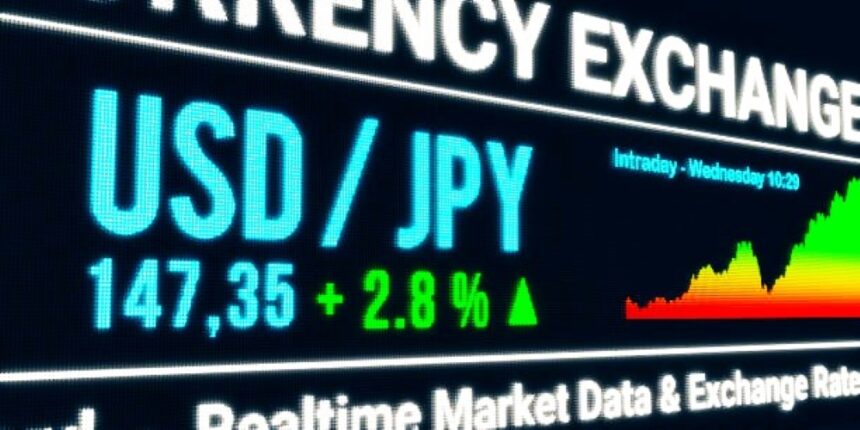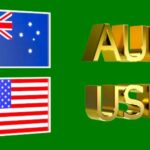Japanese yen Shine as US Dollar Falters Under Fiscal and Policy Pressures.
Japanese Yen (JPY) kicked off the week on a bullish note, capitalizing on mounting pressure against the US Dollar (USD). The Greenback, already reeling from fiscal worries and lower interest rate expectations, finds itself under further strain as contrasting monetary and geopolitical developments support the AUD and JPY.
AUDUSD Touches Six-Month Highs Amid US Dollar Weakness
The AUDUSD pair extended its bullish momentum on Monday, reaching its highest level in over six months. The strength in the Aussie Dollar largely driven by renewed optimism over US-China trade relations and fading confidence in the US economic outlook.
Market sentiment got a boost after the US and China extended a 90-day trade truce and opened doors to broader negotiations, giving a lift to risk-sensitive currencies like the Australian Dollar. The development bodes well for Australia, whose economic fortunes are closely linked to Chinese demand.
RBA Dovishness May Cap AUD Gains
Despite the current strength, the AUD’s upside potential may be restrained by expectations that the Reserve Bank of Australia (RBA) could cut rates further. The RBA slashed interest rates by 25 basis points last week, and Governor Michele Bullock signaled a willingness to ease further if the economic outlook deteriorates sharply.
Markets are pricing in the possibility of another rate cut in the second half of 2025 if inflation continues to slow and global growth headwinds intensify. These dovish expectations could keep the AUD from rallying too far, even as the USD continues to weaken.
China-Australia Relations Pose Risks for AUD Stability
Traders are also watching diplomatic tensions between Australia and China. A key flashpoint is the Australian government’s potential decision to cancel the 99-year lease of Darwin Port, granted to Chinese firm Landbridge in 2015. The Chinese embassy has criticized the move as “unfair and unethical,” raising concerns over how this might affect bilateral trade—especially Australian exports of iron ore, coal, and LNG.
If relations deteriorate further, it could undercut Australia’s trade surplus and pressure the AUD, making the outlook for the currency more volatile in the medium term.
US Dollar Under Fire: Fiscal Deficit and Debt Concerns Mount
Meanwhile, the US Dollar continues to bleed value across major currency pairs due to worsening fiscal indicators and speculation about lower interest rates. The US Dollar Index (DXY) slipped to 98.70, its lowest level in over a month.
A key source of concern is the US federal deficit, which could grow substantially if President Trump’s “One Big Beautiful Bill” clears the Senate. The legislation proposes tax breaks on tipped income and incentives for domestically manufactured vehicles—measures that could add $3.8 billion to the deficit over the next decade, per the Congressional Budget Office (CBO).
Moody’s Downgrade Weighs on US Credit Outlook
Moody’s recently downgraded the US credit rating from Aaa to Aa1, citing rising debt-servicing costs, an expanding entitlement state, and falling tax revenues. The agency forecasts that US debt could reach 134% of GDP by 2035, up sharply from 98% in 2023.
This downgrade follows earlier moves by Fitch (2023) and Standard & Poor’s (2011), further eroding confidence in the fiscal discipline of the US government and contributing to broader USD weakness.
Fed Soft Tone Highlights Divergence from BoJ Policy
Comments from several Federal Reserve officials last week added to bearish sentiment. Fed Governor Christopher Waller noted that future rate cuts remain possible, especially if tariffs and geopolitical pressures undermine growth. Kansas City Fed President Jeffrey Schmid emphasized the need to focus on hard data rather than sentiment surveys, while Chicago Fed President Austan Goolsbee acknowledged that trade policy uncertainty could delay rate decisions.
The Fed’s cautious and increasingly dovish tone stands in stark contrast to the Bank of Japan’s (BoJ) hawkish shift, which is reinforcing the bullish outlook for the Japanese Yen.
Japanese yen Supported by BoJ Rate Hike Bets and Trade Optimism
The Japanese Yen regained strength on Monday after touching monthly lows against the US Dollar. While Japanese yen staged a modest bounce to 142.25, the broader trend remains tilted in favor of the Yen due to a combination of monetary tightening expectations and trade optimism.
BoJ policymakers have repeatedly signaled that they are ready to raise interest rates again if wages and inflation continue to rise. Japan’s latest CPI data surprised to the upside, and market participants are increasingly convinced that the BoJ will hike rates at least once more this year.
Japan-US Trade Talks Offer a Positive Backdrop for Japanese yen
Adding to the Japanese yen appeal are positive developments in US-Japan trade negotiations. Japanese Prime Minister Shigeru Ishiba and top negotiator Ryosei Akazawa expressed optimism about finalizing a trade agreement with the US during the upcoming G7 summit.
Closer trade ties with the US could bolster Japanese exports and improve its trade balance, potentially strengthening the Yen further. Scheduled meetings between Japanese and American officials in the coming weeks may provide more clarity.
Safe-Haven Flows Return on Geopolitical Turbulence
Geopolitical tensions also offer a tailwind for the Yen. Russian forces launched one of the most significant aerial attacks on Ukrainian cities since the war began, drawing condemnation from the US and threatening to trigger fresh sanctions. Meanwhile, Israeli airstrikes on Gaza killed 38 people, including children, intensifying the humanitarian crisis in the region.
In such uncertain times, investors often flock to safe-haven assets like the Japanese Yen, particularly when the US Dollar is struggling under its own economic and fiscal burdens.
Trump’s Tariff Delay and Trade Strategy Remain Wild Cards
The delayed implementation of 50% tariffs on the EU until July 9 has slightly reduced safe-haven demand in the short term, pressuring the Yen. European Commission President Ursula von der Leyen indicated a willingness to negotiate quickly with the US, but the uncertainty surrounding Trump’s protectionist policies still looms large.
If talks collapse or tariffs are enforced, it could reignite risk aversion in global markets, triggering a fresh wave of safe-haven flows into the JPY.
Key Events Ahead: Tokyo CPI and US Data Cluster
Looking forward, the USD/JPY and AUD/USD pairs will be guided by a slew of key economic releases. US Durable Goods Orders (Wednesday), GDP (Thursday), and the PCE Price Index (Friday) will offer critical insights into inflation trends and economic momentum.
Additionally, Wednesday’s FOMC minutes could shed light on the Fed’s internal debate about the path of interest rates. For the Yen, Tokyo CPI figures due Friday will be instrumental in gauging whether inflationary pressures are strong enough to justify another BoJ hike.
[faq-schema id=”39669″]









